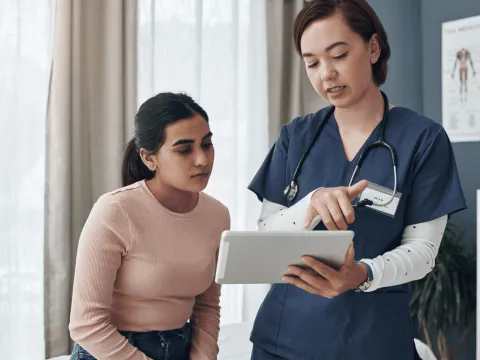- UChicago Medicine AdventHealth

Choose the health content that’s right for you, and get it delivered right in your inbox.
Today we set up our clinic at a local co-op, where local fisherman come to sell fish and other goods. The place is right on the beach overlooking the ocean. The view was breathtaking.
The co-op is normally open to the public, but today it was reserved for us, and patients came from all over to see our medical team. Some walked up the beach from nearby neighborhoods and in the morning, fishermen came right through the clinic carrying large buckets full of fish.
We set up on the sand-covered floor and had a steady stream of patients all day, a total of 383 in all. Still a little short on interpreters, we got help from some people who worked at the hotel where we are staying. Ismael Gama, senior vice president and chief mission officer, helped interpret for the pharmacy team. It’s one of the most demanding spots because every medication needs to be explained in very specific detail. Things like lip balm, floss and sunscreen — Connor Leuck and Marianne Gockman had to teach people how to use them.
Many of the patients who made an impact today were children. Dr. Stephanie Freels, our dermatologist, treated a 13-year-old boy who was born with two accessory ear tags. These are pieces of skin and cartilage right in front of his ear. He was being teased at school and his mother brought him to the clinic. He wanted to have them removed but he was scared. “His mother told him there might not be another opportunity,” Freels said. “He was very brave, and I removed it. He told my interpreter, Jennifer, ‘Nobody is going to make fun of me anymore,’ and then he hugged me.”
Dr. Mary Lewis, our pediatrician, saw a 10-year-old girl who had been unable to hear for three years. “She just had a really bad case of what we call Swimmers Ear,” Lewis said. “We gave her ear drops to use for a week and she should be much better.”
A 24-year-old man with developmental delays who lives with his mother came to the clinic. He had a colostomy five years ago and since then his mom had been using homemade supplies to care for him. She cut fabric and used kitchen bags as supplies and now a rash was spreading across his abdomen. Gockman used MacGyver-like skills to create a skin barrier to provide more protection. Freels treated the man with topical medications and prescribed oral anti-fungal meds and antibiotics. They sent him home with an abundance of supplies and referred him for follow up care.
One man and his wife walked up the beach to the clinic. By the time they arrived, the man short of breath and very pale – he could barely breathe. He said he had pain on his side, and Dr. Rema Johnson thought he may be having a heart attack. He said he has a history of asthma and COPD, so our team sat him in a chair and carried him to the pharmacy, where there was power to give him a nebulizer treatment. His wife began to cry – she thought he was dying.
His color went from ashen to rosy after the second treatment. Johnson wanted him to go to the hospital, but they were adamantly against it. It felt like they equate hospitals with dying, and there’s no way they were going. He explained he has an oxygen tank and a nebulizer at home, but it was too heavy to carry to the clinic. We arranged for the police who are providing security at the site to give him a ride home.

